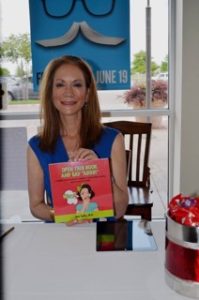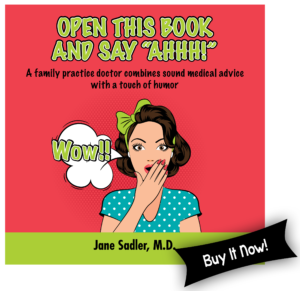

















![]()
Loved our time together! Thank you
Open This Book & Say "Ahhh"
By Jane Sadler


















![]()
Loved our time together! Thank you
By Jane Sadler


I am sleeping standing up. The dog took up most of my feet space and my husband inched over to the rest of the “me” space. Not that I mind a good snuggle…but can a girl get some sleep around here? It takes me a while, but then as soon as my sleep-deprived body awakens, Become more clear in my morning thoughts and I remember…I was supposed to blog about Better Sleep Month! Now that it is May 31st, the month is almost over. But not quite enough over to review the incredible importance of healthy sleep.
According to Dr. Larry Altshuler, director of Sleep Medicine at Cancer Treatment Centers of America, I am not alone in suffering sleep deprivation. Approximately 1/3 of Americans have chronic insomnia and about 74% of people will experience sleep problems intermittently in their lifetime.
A common sleep disorder, sleep apnea is a condition where you may take several pauses or shallow breaths while you sleep. Approximately 90% of people with sleep apnea do not know they have problems with getting enough night time oxygen and therefore do not reach healthy sleep levels. People with sleep apnea have a 5X increased risk of cancer-related deaths!
If you or your partner are concerned about the quality of your sleep, then a sleep study is a good idea. For mild sleep apnea, an oral device may suffice; however, specific oropharyngeal exercises (taught by a licensed speech therapist) may improve sleep apnea by up to 50%.
Good sleep is NOT over-rated! Sleep deprivation whether due to decreased sleep hours or sleep quality (i.e. apnea) causes decreased alertness, creativity, and overall performance according to Dr. Altshuler. Adults are not the only ones who suffer sleep disorders. Children with poor sleep habits are crankier and less adaptive to their environments; and, along with adults, are more likely to experience attention deficit. For most adults seven to nine hours (for children) a night is enough sleep.
Quality of sleep may be disrupted by stress and blue-light (electronics) exposure close to bed time. Dr. Altshuler recommends not to use our electronic tablets up to one hour prior to sleep. However, he does agree that the purple or red filters can help negate some of the blue light mal-effects on our sleep (look for these specialized programs available on the App Store).
Conquering poor sleep with a cat nap can be a good idea. NASA scientists found that a quick nap can increase alertness by 100% and improve performance by up to 34%. A 10-20minute power nap is most effective explains Dr. Altshuler. After approximately 30 minutes, people may experience sleep inertia; a sense of grogginess and difficulty overcoming their sleepy state.
Studying in Spain, my daughter is learning all about the siesta. Here, they take nap time seriously but unfortunately they also stay up very late into the evening and therefore do not exude the ultimate sleep health. NPR reports that the Spanish have some of the highest incidence of work-related accidents in the world and (for many reasons) the siesta may be going the way of the dinosaur.
Not feeling rested in the morning? Turn off electronics, go to bed earlier, consider a sleep study if needed. Still feeling tired? Sleep on it: A short nap could do all of us a world of good!
By Jane Sadler


Are you in your 50’s? Do you have risks for heart disease? Do you have a family history of colon cancer? If you can say “yes” or “I don’t know” to any of these questions then pay attention!
Cardiovascular disease (CVD) is the number one cause of morbidity and mortality in the world. Colon cancer (CC) is the third most common cancer in men and women. Daily low dose aspirin can reduce the risk for CVSD and CC by as much as 50%. The United States Preventative Services Task Force (USPSTF) released the latest recommendations for daily aspirin use on April 2016.
For adults ages 50 to 59 years who have greater than a 10% chance of suffering a cardiovascular event (stroke, heart attack, aneurysm, etc.), an 81 mg daily aspirin of aspirin could improve health outcomes.
Before you jump on the aspirin-train, determine your personal heart disease risk category. One of my favorite calculators for estimating cardiovascular (CV) risk is the Cardiac Risk Assist APP available on your android or iPhone. MOST IMPORTANT: For those who meet criteria: These guidelines are intended for people with low risk for bleeding, have a life expectancy of at least 10 more years and are willing to take daily aspirin for a total of 10 years (in order to reap benefits).
People older than 60 years who are considering low dose aspirin for primary prevention of CVD or CRC should review personal risk factors with medical provider. Potential harms associated with aspirin include excessive bruising, bleeding (including gastrointestinal bleeding).
Younger than 50 or older than 70? The jury is not out. Higher risks of gastrointestinal bleeding may make the use of aspirin for primary prevention (of stroke/heart attack) less appealing and potential dangerous.
** According to the Annals of Internal Medicine, nearly 40% of U.S. adults over 50 already take daily aspirin to prevent first time heart attack or avoid a second one.
Thank you,
Dr Jane
written with the help of Bailey Baker TAMU Class of 2018
By Jane Sadler

“Look what the dogs brought it the house!” An urgent text from my daughter with attached photo revealed a large river rat lying on our floor. Quite lifeless, its pitifully ugly body did not reflect a peaceful death.
“Get it off the floor!” I rapidly text my daughter, I was in no mood to face the stench when I got home from the clinic, “Then wash your hands!” Work done? Not quite yet.
When I arrived home the kids were quick to boast their brave handling of a dead animal. Their quick-thinking method of nutria (large rat) removal? “We never touched it.” The kids had discarded the large rodent-filled bag in the kitchen garbage can. Great.
Who was I to criticize their scientific method? Honestly, other than throwing the darn thing outside in the trashcan, I would not know how to properly dis pose of our dead little friend. It was time for me to consult my “go to”: The Centers for Disease Control and Prevention.
I was not surprised to find that rodents carry a multitude of diseases . However, I never considered the dead carcass a vector for leptospirosis, Hanta Virus, and salmonella (among others).
For future reference: The CDC recommends soaking the rodent and surrounding area in a bleach solution for about five minutes. Guidelines suggest placing the animal in a tightly sealed bag then throwing the bag into a covered trash can that is regularly emptied (not in the kitchen!). Lesson learned.